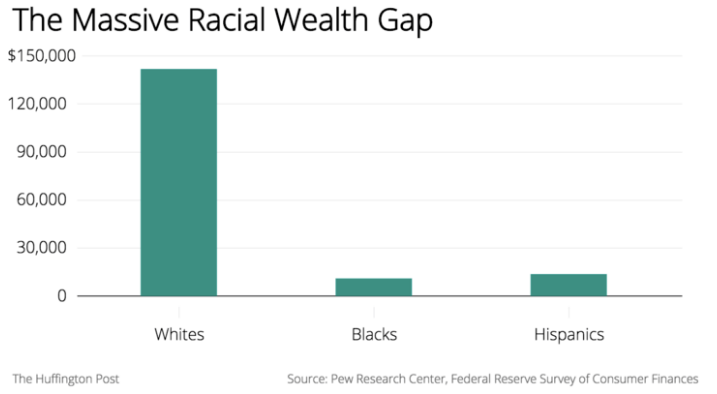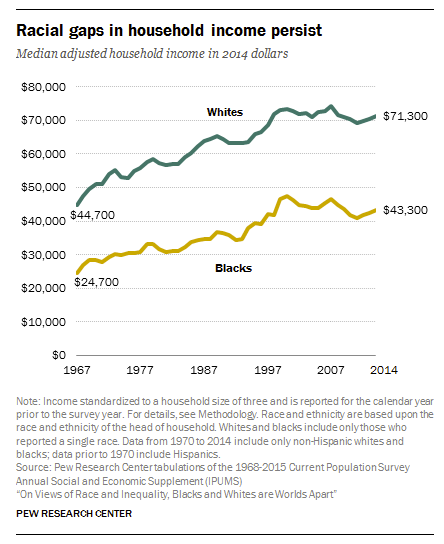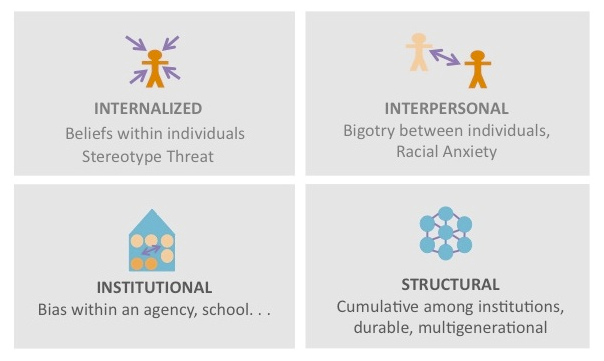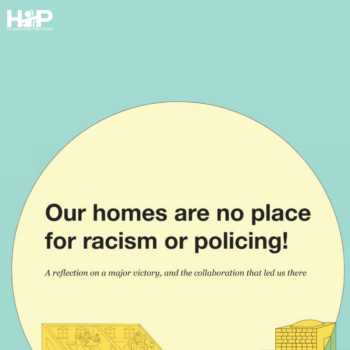
| By Holly Avey |
Earlier this year, I published a post talking about the wealth inequities of proposed federal policies. (Remember: wealth = assets minus debts). Beyond talking about how these changes would heap more money on the rich while starving the poor, we also need to discuss the huge wealth differences between Black and White people in our country.¹
The racial differences in income are disheartening
The distinction between wealth and income is very important when we talk about racial disparities. If we only look at income, the disparities don’t look nearly as bad as they really are.
For example, if you look at the graph below, you would see that White households have had almost twice the income as Black households for nearly 50 years. The difference has barely changed for that long.
The racial differences in wealth are massive
But if you look at wealth instead of income, the difference is not twice as much. It’s more like thirteen times as much. In 2013, the median wealth of White households was $144,200 compared to $11,200 for Black households.

Source: Huffington Post, quoting Pew Research Center
And this massive imbalance hasn’t stayed the same over time. The imbalance in wealth between White and Black households has fluctuated over the last 30 years from 8 to 17 times more. The Great Recession definitely made things worse when many people of color lost a big source of their wealth in the foreclosure crisis. That’s horrifying. So, what’s the story?
Our past: the story of cumulative discrimination
Racism goes way beyond just interactions between people. It’s also built into laws, policies, and systems that block opportunities and equal access to resources.
Wealth imbalances between Black and White people provide the paper trail of past discrimination. They show how blocked access to resources can accumulate over time. Research shows this started with slavery and segregation.
Other government policies have kept the wealth differences in place, or made them worse:
- Redlining blocked access to home ownership for the Black community.
- The GI bill promoted home ownership and college education, but it basically excluded Black soldiers.
- Social security also excluded the jobs most Black people had.

Role of government policy in creating massive racial wealth differences
Our present: wrong policies for wrong problem
Racial wealth imbalances tell a different story in the present. These imbalances reveal a lack of understanding about racism. Many people don’t know about the role government policies played — and continue to play — in today’s racial economic differences. They don’t know how those problems have gotten worse over generations. They don’t know how bad the problem is. They assume there are other reasons for the problems. This leads to policy suggestions that won’t solve the problems.
A lot of people don’t think racial equity is a problem. In 2014, the Pew Research Center did a survey of over 10,000 Americans. They asked people their opinions about politics and current problems in our society. One of the questions asked: Has the U.S. made the changes needed to give Blacks equal rights with Whites, or does it need to continue making changes? Almost half of those who responded (49%) answered that the U.S. has already made the changes needed.
A lot of people think individuals are to blame for racial economic inequities. That same survey asked people about the main reason many Black people can’t get ahead. Nearly 2 out of 3 (63%) answered, “Blacks are mostly responsible for their own condition.” Less than 1 out of 3 (27%) answered, “racial discrimination is to blame”.
Other research shows that people think racial economic inequities are a result of individual choices. They think life choices explain the differences — like marriage, children, or how much money people spend. They also think it’s because of how much individuals have achieved — things like education level and work status.
These racist stereotypes are still around, even though researchers have carefully proven them all wrong. Researchers have even shown the opposite. They have shown that Black people spend less than White people in the same income brackets. They have shown that Black people still earn less income than White people even when they have the same level of education or type of job. But if people don’t understand the real reasons for these differences, they will keep sliding back into the reasons they’ve always heard.
Massive racial wealth imbalances won’t go away with individual behavior change. Racial wealth imbalances were created by policies and they can only be changed by policies. But we need the right policies to fix the problem.
Researchers estimate it will take 228 years for a Black family’s wealth to catch up to a White family’s wealth. That’s if policies don’t change — recent federal policy changes have likely already made things worse.
Still, advocates have been successful with some policy changes focused on income. In recent decades, 20 states tried to pass a minimum wage increase and 18 were successful. Between 2014 and 2016, 42 cities and countiespassed local minimum wage increases. Universal Basic Income is being testedin the U.S. and abroad. That is a policy to offer the same basic income to every person, no matter their income or work status.
But we have to remember three things:
- Income inequality is not the same as wealth inequality. We need to focus on policies that will build enough income to cover debts and build wealth.
- We can’t reduce the imbalance just by increasing wealth for those with the least. We must also address the policies that are increasing wealth for those who already have the most.
- This is not just a small difference or imbalance. Things are completely out of whack. We need major change to get back on track. If not, we will continue to destabilize our economy and the social fabric of our country.
Our future: why it’s important to spread the wealth now
People can share their wealth with future generations. Parents can use their wealth to access high quality education and college for their children. They can also use wealth to help adult children make down payments on their first home.
People of color who are the first generation to build wealth often end up offering these protections to older generations, rather than the other way around. This further limits their potential for wealth growth. This means that building wealth when you have none takes time. We need to change policies now to benefit future generations of Black families.
Some state and local governments have made efforts to address wealth imbalances:
- Minnesota has raised their minimum wage and increased taxes on the rich.
- Other state and local governments are proposing bills that cap CEO pay at 100 times that of the lowest paid worker.
These efforts can keep the wealth differences from getting bigger, but they are not specifically focused on addressing the race element of wealth differences.
More and different policies are needed to have fair racial wealth distribution. The organization Demos has created a Racial Wealth Audit ™.They tested it on housing, education, and labor market policies. They used it to estimate how much changes in these areas could change wealth differences between Black and White families.
Their estimates are not cumulative. They are specific to each policy and each racial group. They show:

Economist Darrick Hamilton argues that it is wrong for economists to remain neutral when economic policies have racist impacts. Hamilton and the Demos researchers have studied different policies that could affect the racial wealth imbalances.
They offer the following policy suggestions:

In summary, the fact that White families have 13 times as much wealth as Black families is a major problem. In our connected system, it is destabilizing our economy, our social fabric, and our democracy. But it can also be a tool and an opportunity. It can help us explain, in real terms, how past discrimination still influences the present. It can help us change the story from individual choices to blocked opportunities and resources. And it can help us focus our efforts on the policies that can create the best future.
1. In this post, I mostly focus on the wealth imbalance between Black and White people. The wealth imbalances between Latinx and White people is very similar, though slightly less. These imbalances are caused by many of the same problems. It is likely that there is a wealth imbalance between Native American and White people too, because of similar problems, but unfortunately data is not available for this group. The wealth imbalances between Asian and White people is hard to measure, because it depends on how you measure different Asian groups and data for this group has not been collected as long.
2. Latinx is a gender-neutral alternative to Latino/a






